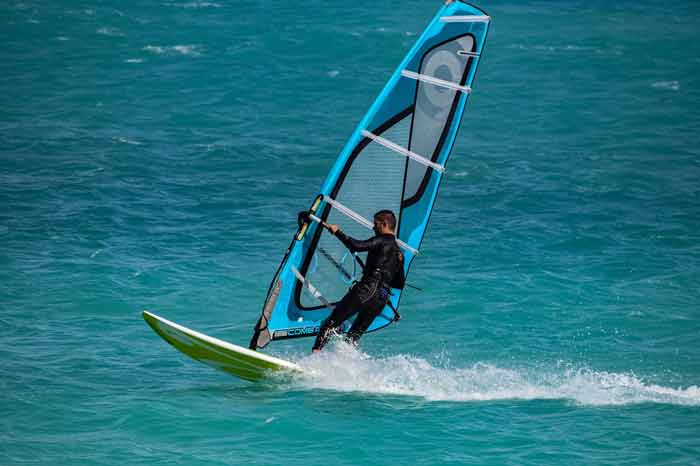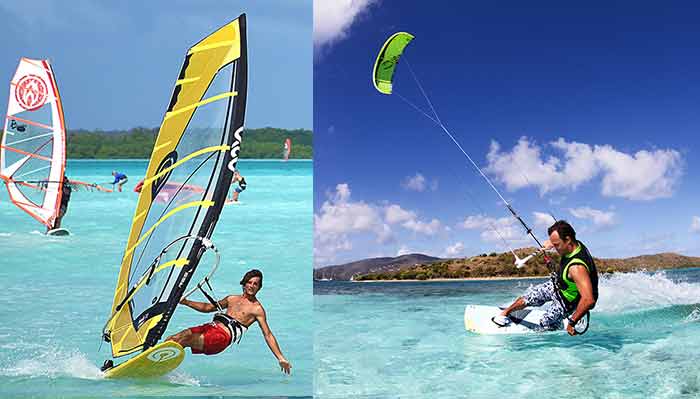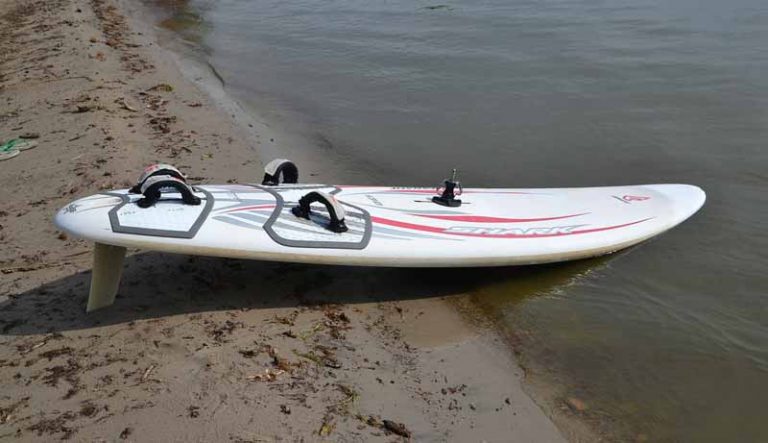Windsurfing Sails & Rigs Sizes, Best Brands+ Buy Guide
A sail plays an important role when windsurfing. It is through the sail, usually attached to a rig, that the ability to move on the water surface is derived from.
The market offers different types, designs, sizes and brands of windsurfing sails. If you’re intending to replace your old sail or buy a new one, following is discussion on the sails, their role, parts, types, review of some of the best plus what to look for when shopping used or new sails.
What a Windsurf Sail is + Role
A sail is a flexible construction in most cases created from fabric or other membrane materials. It makes use of wind power to propel during windsurfing.

The role of a sail is to yield a forward-pushing force through a combination of lift and drag. This will be determined by the angle from which wind will hit the sail.
The functioning of a sailboard depends on the conditions of the wind, how skilled the rider is as well as the intentions of the sailor. The sail therefore will either hydroplane or sail
Based on history, the use of sails was first depicted around 3200 BCE in the ancient Egypt where boats sailed in the Nile River. It is believed that the Sumerians used square rigged sailing boats during this moment hence establishing the sea trading routes as far as in the Indus Valley.
What is a Sail made up of?
A blend of woven materials normally in a three- or four-sided shape is what makes up windsurf sail. The materials include; canvas or polyester cloth, laminated membranes or bonded filaments.
Windsurfing sails are available in three materials: Dacron, Mylar, and Monofilm.
Dacron: This is China’s Polyester fiber. It is lightweight but can stretch out of shape.
Mylar: Coated dacron. Holds shape better than dacron, but is subject to delamination(peeling off) over time.
Monofilm: Newer material which holds its shape better than mylar. Monofilm is clear, allowing good visibility, and strong. It is the sail material of choice on many of the newer boards.
Initially, the sails were made of linen which was believed to be good resistance of the Ultra Violet rays, rot and water absorption.
However, back in the 19th century, the creators decided to use cotton since it was in plenty. In the late 20th century, these natural fibers were replaced by synthetics which are used till date.
Size and Range Chart
Normally, the size of the sail ranges from 3 square meters to5.5 square meters in the case of the wave sails. Although, the race sails come in sizes of 6 square meters to 15 square meters in different ranges. You are advised to use sails with the size of 0.7 square meters for kids.
Following is chart by Neil Pryde showing wind range in regard to sail size and wind.

Note: the blue color is the usable range while the green is the ideal wind-range based on an 80kg windsurfer. This is dependent on water conditions, rider skill level and the size of the board in use.
Parts & Designs
Following is are illustrations showing parts of a rig which is composed of a sail.
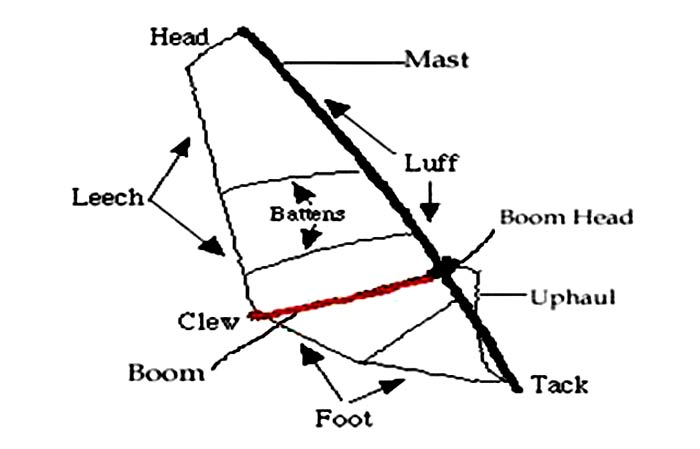
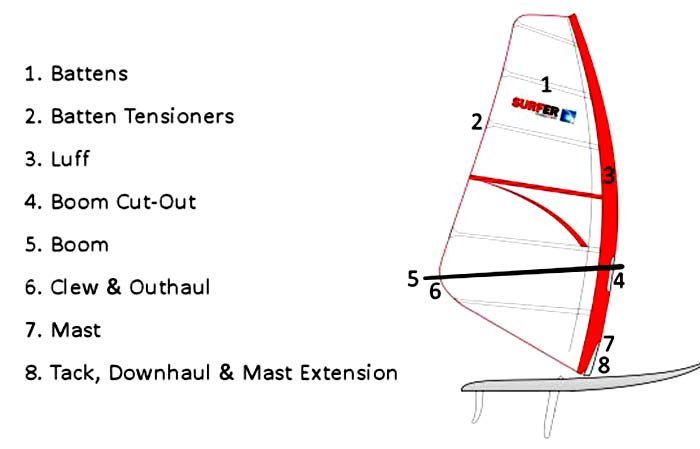
There are two designs of a sail; camber induced design and the rotational type. Camber refers to symmetry between two acting surfaces of an aerofoil and therefore, camber sails have 1-5 camber inducers. In most cases, beginners’ sails are normally lighter and easy to use in light winds as they have no battens.
On the other hand, rotational sails have battens that extend at the back of the mast. They move round the sides of the mast when jibbing. Additionally, unlike cambered sails, they provide less power and stability in cases where you are sailing straight. However, when maneuvering the directions, they are normally lighter and easier to use.
The difference between a windsurfing board and a windsurfing sail is that in a board the mast is supported on a board deck while in a sail the mast is self-supported. Therefore, the sailor must hold the mast as there are no rigs to support it.
In a sail, you are responsible for controlling the direction by moving the mast and entire sail to alter the wind forces which may act against the fin.
Types
Normally, sails are of different kinds depending on the type of windsurfing activity you are undertaking, either for recreational purposes or competition. The types of windsurfing sails include the following;
Wave sails
This class of sails is made for stronger winds, which makes them seem smaller than any other sail type. Just as the name suggests, they are made to be used in waves hence have their panels well designed to ensure that no breakage in case of strong waves of force applied when you kneel on them.
Additionally, the battens used in their profile are normally strong to prevent snapping in cases when waves break on the sail. Moreover, they have short boom with very little or no surface below it to avoid any destruction by the waves.
Slalom sails
Unlike the wave sails, these are made to be used in conditions of light winds when you need to propel at high speeds. Additionally, they are built with light material so as to accelerate their speeds since they are normally small in size.
Despite their light material being an advantage in terms of increasing your speed in water, it has a demerit in that they are fragile and in case of any accident in the sea they can be easily swept by water. Furthermore, some of these sails are designed to have cambers that calm down any unnecessary turbulence that may occur in the mast.
Free ride sails
Free ride sails, commonly known as lightweight sails are those used with lighter winds. However, unlike most of the sails, this class is hardly used for competition purposes.[2] They are commonly used for fun and socialization or recreational purposes.
Beginner sails
This is another class of sails which greatly depends on the size, age and weight of the sailor.[3] In this case, the sail to be chosen is required to be of a soft material which in most cases is usually Dacron and Polyvinyl Chloride.
Light material is of great importance as it prevents you from getting exhausted faster while in use. Additionally, this is so as to prevent hurting individuals as well as enabling you feel comfortable and safe while still in the sea.
In the case of kids, the choice greatly depends on the age. Soft sails for kids help them gain and build their confidence. Furthermore, you are advised to choose a sail that is easy to control making your sailing easy and fun.
Freestyle sails
This type of sails class is ideally used on flat waters; however, it also makes use of moves and tricks from other sail types such as in wave competition. Generally, it involves using of jumping tricks on water where most sail and board moves are practiced.
They are almost similar to wave sails, however; they are wider and have a greater capacity which is specified for carrying out acrobatic tricks. For sure, you can’t miss watching this type of sails since is one of the most interesting styles that comprise of simple and tricky improvised rotations using a board and a sail.
Olympic windsurfing sails
The equipment comprised of a high-level technology rig with mast and boom and a wide style board that made it easier for the competitions to be held in any condition.
Its stability provides a high concert locked in feel in planning conditions. However, it also performs in non planing conditions due to its light weight and high performance.
RS: X allows for the participation of both men and women hence attracting the best windsurfers to the event. Although, it is rare to find this type of sail or practically put them in use unless you are participating in this competing class.
There are however other types of sails such as the in-between sails that are usually made of a mixture of two of any of the above kinds. For instance, a freestyle-freeride or wave-slalom windsurfing sails are example of in-between sail among others.
Choosing the Right Windsurfing Sail
Windsurfing sails wear faster than boards and therefore need to be replaced more often. Be it you’re just beginning or a pro, or just don’t purchase any sail but instead look for some factors and features that will work for your specific needs.
Here are some guidelines to use when you need to purchase one;
Windsurf Sails Battens
The battens are basically the rods that support the aerodynamic profile. In terms of the sail’s performance, the foil profile is flatter and softer whenever the battens are loose.
Following is a video explaining the types of battens and which are best for achieving the right tension as well as the most suitable for repair and replacement
Size of the sail
The size of the sail you need to purchase depends on its purpose alongside the place you do the windsurfing activities. For instance, in El Medano, the sail required is normally around the lines of 4.0, 4.7 and 5.3 which differ with those of other lakes that are above 6.0.
Therefore, it all depends on whether you are sailing in a lake, river, sea or ocean. This therefore brings another important aspect to consider when purchasing the sail of where you are going windsurfing.
Moreover, the size of the sail is also affected by your weight and level of sailing skills. You are advised to first know your weight before purchasing any sail so as to act as a guide on the sail size to be purchased.
The type of the sail
Generally, the type of sail you are undertaking will largely impact the choice of your sail. For instance, if you are a beginner then the sail required to be that which can make you free to do any tricks without restrictions so as to try all new moves learnt. This may include a freeride sail without cambers.
Further, after the use of many types of sails, you can have that of your choice. This will greatly depend on how you feel when using it and the impact it has on your body after the use.
How well it fits the available mast and boom
In most cases, this is put in consideration if you already have a mast and a boom that you acquired using whichever means. Maybe they were on offer or a friend gave them to you. That does not really matter much as you only need an expert to help you purchase a sail that matches them.
This aspect is normally put in contemplation as some manufacturers usually have a specific size and shape of the sail in mind while producing the mast and booms. Due to this factor, you are required to purchase the sail that is compatible with your given mask so as to achieve the maximum speed of ride required.
In addition to this, the length of the sail determines the stiffness of the mast. Therefore, you are urged to make a good choice of the sails’ length that will give a perfect sail profile which enables the sailor ride at a faster and easier way.
The type of sails you already have
In cases where you are purchasing a sail to be able to increase the wind range then, you are encouraged to ensure that you choose one that will not leave a gap that is too big or too small.[4]
Furthermore, this all depends on the type of winds that you want to sail in. The level of tuning you want to achieve for each sail also impact on the type to go for.
Fixed mast top or variable top
This is closely related to the discussed factor above. However, in this case, you are encouraged to consider whether the mast that you have can be adjusted to fit the length of sail purchased and if not ensure that you purchase a sail with a variable top.
Although, you are supposed to put in mind that most sails are designed to be used with specified mast lengths, stiffness and extension and therefore required that you perfectly match your mast size with the sail length.
Best Brands
Some of the top brands that create good windsurfing sails include;
- Bic Windsurf sails
- Ezzy
- Gaastra
- RRD
- Chinook
- Starboard
- Kona
[1] https://en.wikipedia.org/wiki/Sail
[2] http://howtowindsurf101.com/disciplines-in-windsurfing/
[3] https://www.boardshop.co.uk/blog/choosing-a-beginners-surfboard/
[4] http://howtowindsurf101.com/windsurf-sail-buying-guide/

